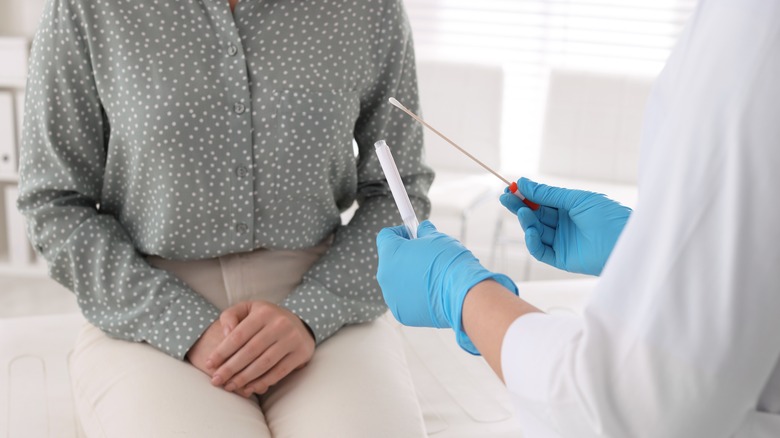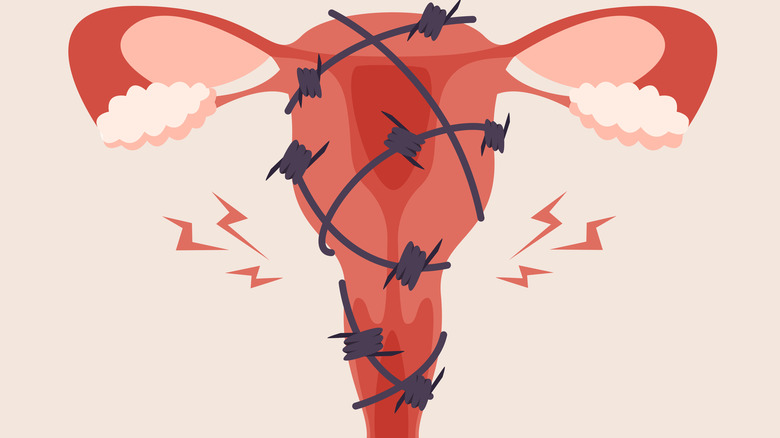Reasons You Might Be Experiencing Breakthrough Bleeding
Breakthrough bleeding is about as welcome as a run in your new black tights, surprise acne before a first date, or (let's be honest) your actual period showing up right before a beach vacation. But unlike your period, which signals the start of your menstrual cycle and functions like a barometer for your reproductive and hormonal health, breakthrough bleeding can happen at any time.
Breakthrough bleeding, also called spotting, is usually lighter in both color and flow compared to a regular period. Menstrual blood can range from bright red to dark brown and, at your period's end, black. Spotting is usually light brown or pink. Menstrual flow also tends to be heavier than breakthrough bleeding.
Most women have, or will, experience breakthrough bleeding at some point, according to Medical News Today, and some women experience spotting fairly frequently. If you're one of them, don't panic! You're in good company. While breakthrough bleeding can be frustrating or annoying, it doesn't necessarily signal a medical emergency. However, that's not to say you should not ignore breakthrough bleeding, as there are times when it can signal serious health conditions. It's important to listen to your body and consult your doctor when anything is amiss.
Understanding your cycle
The female reproductive system includes two ovaries. Their function is to produce eggs and hormones — the primary hormone being estrogen. Hormones regulate the release of eggs and prepare the uterus for implantation and fertilization. If there is no fertilization, the body sends a message to stop producing hormones, and the lining of the uterus sheds (this is your period). Within a week or two, a fresh lining appears, and the cycle starts all over again. The average cycle is about 28 days, but this can be shorter or longer depending on what's normal for your body. When your cycle and period are both regular, things are working as they should.
Depending on your age, breakthrough bleeding can be nothing to worry about. Premenstrual young women may have spotting just before getting their first period, or menarche. For those old enough to have a menstrual cycle, breakthrough bleeding can be caused by a variety of reasons. Here's a closer look at some of the most common causes of breakthrough bleeding, what you can do to address it, and when to consider talking with your health care provider.
Birth control
If you're on birth control — whether that means you take a pill, have an intrauterine device (IUD), have a contraceptive implant, or use a patch or a vaginal ring — there's a good chance you'll experience breakthrough bleeding at some point. "Breakthrough bleeding happens more often with low-dose and ultra-low-dose birth control pills, the implant, and hormonal IUDs," Dr. Valerie French explained in an article for the American College of Obstetricians and Gynecologists. "It's also more common when women who use birth control pills or the ring take a continuous dose of hormones to skip their periods altogether."
Hormonal forms of birth control contain a lab-made version of progesterone called progestin, which alone or in combination with estrogen works to prevent ovulation; thicken cervical mucus, which makes it harder for sperm to access the uterus; and thin the uterine lining, which discourages eggs from implanting. One of the most common side effects in the early months of the body adjusting to the hormones is breakthrough bleeding.
Spotting can also be a symptom of non-hormonal IUDs, like the copper ParaGard IUD, according to the Mayo Clinic. Options for addressing birth control-related spotting include changing from ultra-low to low-dose pills, trying another form of birth control, or taking estrogen pills alongside your current birth control regimen. "Although breakthrough bleeding with birth control isn't physically harmful, it can be really annoying," French explained. "No matter the situation, talk with your ob-gyn if you're unhappy with your bleeding."
Stress
A menstrual cycle is your body's way of signaling its reproductive and hormonal health, but that cycle is also super sensitive to your emotions. Like Santa Claus knowing your sleeping schedule and behavioral patterns, your uterus knows when you are anxious and when you are stressed.
In response to a Kotex customer's question about stress causing spotting on Kotex.com, physician assistant Michelle Petropoulos explained, "Emotional stress (depression, anxiety, worry, insomnia) and physical stress (weight loss or gain, illness, poor diet) can both affect your menstrual cycle." When the body experiences stress, it produces a hormone called cortisol, which helps regulate the body's stress response.
One side effect of high cortisol levels is a drop in estrogen and progesterone, according to Petropolous. To counteract cortisol levels and lower your stress, try to exercise regularly and make a habit of getting good sleep. Meditating and maintaining healthy relationships can also contribute to lower stress levels.
Emergency contraception
If you've recently completed a morning-after pill regimen, you might experience breakthrough bleeding. Emergency contraception, such as Plan B One-Step or Ella, prevents or delays ovulation. It's taken after having unprotected sex or a birth control failure, like a condom breaking. Emergency contraception is not a form of abortion.
According to Planned Parenthood, you might experience breakthrough bleeding after taking the morning-after pill. This bleeding could be lighter or heavier than usual and occur earlier or later than other times you might have taken emergency contraception. However, you should call your doctor if you experience very heavy bleeding for several days, develop abdominal pain, or haven't gotten your period in four weeks, The Pill Club advises.
An IUD can also be used as a form of emergency contraception if it is placed within five days of unprotected sex. Breakthrough bleeding is possible whether an IUD is placed as regular birth control or as emergency contraception.
Vaginal injuries
Vaginal injuries are different from menstrual bleeding, but their symptoms look similar and it's important to know the difference.
One example of a vaginal injury is a vaginal laceration, or a tear in the vaginal wall. These tears can be caused by low estrogen levels, or by rough sex or vaginal penetration with a foreign object, resulting in postcoital bleeding, OB-GYN Andrea Chisholm explained in an article for Verywell Health. The vaginal wall doesn't usually tear, Chisholm wrote; however, a laceration can happen if the vagina is dry and not lubricated ahead of intercourse. Vaginal bleeding following sexual intercourse is oftentimes heavy and red. "A minor vagina laceration might only bleed a short time and then stop, though the pain can last for up to two weeks," Chisholm wrote.
Vaginal bleeding can also result from a straddle injury. These injuries are caused by actions like falling on a fence or the arm of a chair, according to Saint Luke's Health System. Treatment for straddle injuries may include bandages, cold compresses, warm baths, or in more serious cases, surgery.
Medication and surgical abortions
Breakthrough bleeding is a common symptom of both medication and surgical abortions. A medication abortion, also called the "abortion pill," is actually two pills, which are taken to end a pregnancy. The first pill stops the progress of a pregnancy, while the second pill empties the uterus by activating both cramping and bleeding. According to Planned Parenthood, the process resembles a first-trimester miscarriage or a very heavy period.
An in-clinic, or surgical, abortion, on the other hand, uses suction and/or medical tools to empty the uterus. According to the Clinical Practice Handbook for Safe Abortion, women can experience light bleeding or spotting after a surgical abortion, while a medical abortion may have heavier bleeding that can last more than a week.
Although bleeding following an abortion might look like a period, they are not one and the same. Your period should return a month or so after your abortion. In the meantime, Healthline advises getting medical help if your bleeding becomes so heavy that you are going through two or more pads per hour for more than two hours in a row; you have severe back or stomach pain; or if you have fever and chills.
Miscarriage
Breakthrough bleeding is one of the most common signs of a miscarriage. In some cases, the body will pass the tissue on its own; other times, medication or surgery may be needed. Light bleeding or spotting can go on for a month or longer after a miscarriage, OB-GYN Rebecca Cohen explained in an article for the American College of Obstetricians and Gynecologists. "You'll have a similar experience whether the tissue passes on its own or you take medication," she wrote. "You'll have bleeding and cramping that are heavier than your normal period."
A woman's cervix may bleed more easily because pregnancies trigger the development of more blood vessels in that part of the uterus. Most women get their first period post-miscarriage about two weeks after spotting or light bleeding ends, according to Cohen.
It's important to note that bleeding early in pregnancy is common. According to the American College of Obstetricians and Gynecologists, up to 25% of all pregnancies involve bleeding in the first trimester. Still, even if it turns out not to be a serious problem, you should consult your doctor if you have any bleeding during your pregnancy.
Sexually transmitted infections
Along with the health concerns and undeserved stigmas linked to sexually transmitted infections (STIs), breakthrough bleeding is a symptom of some of these infections.
One example is chlamydia. While some people don't experience symptoms of this bacterial infection, it's important to get tested. Chlamydial infection can lead to inflammation, which in turn can cause breakthrough bleeding, as well as postcoital bleeding, according to Verywell Health. And if left untreated, chlamydia can harm the reproductive system. Gonorrhea can also cause breakthrough bleeding and infects the reproductive tract's mucous membranes. Many infected women are asymptomatic, and if they do have symptoms, they can appear to be related to a bladder or vaginal infection, according to the CDC.
If left untreated, gonorrhea and chlamydia can cause abdominal pain and fever, or even lead to pelvic inflammatory disease (PID), an infection of a woman's reproductive organs. Unfortunately, there is no one conclusive test for PID, but its symptoms include bleeding between periods.
Polycystic ovarian syndrome
Breakthrough bleeding can be a symptom of polycystic ovarian syndrome (PCOS). When a person has PCOS, the ovaries can develop cysts (small sacs of fluid), according to the U.S. Department of Health and Human Services. PCOS can cause ovaries to develop eggs incorrectly or release eggs as they normally would. According to a 2020 paper published in the Journal of Human Reproductive Sciences, about 10% of women globally are diagnosed with PCOS.
While not every instance of breakthrough bleeding signals a PCOS diagnosis, it's worth talking to your doctor if you are having trouble getting pregnant, or if you're displaying signs of excess androgens — another symptom of PCOS. High levels of androgens can cause excess body and facial hair and can interfere with ovulation.
"If a woman has fewer than eight menstrual periods a year on a chronic basis, she probably has a 50 to 80% chance of having polycystic ovary syndrome based on that single observation," John Nestler, the chair of the department of internal medicine at Virginia Commonwealth University, told The Atlantic. "But if she has infrequent menstruation and she has elevated levels of androgens such as testosterone in the blood, then she has a greater than 90 percent chance of having the condition." Factors like genetics, low-grade inflammation, and insulin resistance can contribute to a PCOS diagnosis. The cause of PCOS is unfortunately unknown, which means treatment focuses on addressing symptoms.
Uterine fibroids and cervical polyps
Although uterine fibroids and cervical polyps differ in their composition, they both share symptoms of breakthrough bleeding. Fibroids develop in the uterus and are made of smooth muscle cells, according to Johns Hopkins Medicine. They are non-cancerous and although they are not often accompanied by symptoms, bleeding between periods has been recorded as a symptom.
Unlike uterine fibroids, cervical polyps grow out of cervical tissue. "They're like skin tags arising from the surface of the cervix or in the cervical canal," Dr. Nicholas Rogers, an OB-GYN, told Self. Rogers explained that a vagina's acidic pH can irritate the polyps, which in turn can cause spotting. If the polyps are not accompanied by symptoms, a doctor might not feel the need to take them out; however, if a polyp looks strange, a doctor will remove it, OB-GYN Katharine O'Connell White told the publication. "Polyps have a particular look to them, so if the polyp looks odd, those are the times we worry," the doctor explained.
Cervical, endometrial, or uterine cancer
Many times, the cause of breakthrough bleeding isn't due to something serious. However, cervical, endometrial, and uterine cancers can each exhibit symptoms of breakthrough bleeding, abnormal bleeding, changes in the menstrual cycle, or bleeding after menopause. Importantly, postmenopausal women should pay particularly close attention to breakthrough bleeding.
If you've been bleeding for more than a year after your last menstrual period, the Cleveland Clinic recommends consulting a doctor. While this could be a symptom of an infection or benign growth, like a polyp, it could be something more serious, like uterine cancer.
When speaking with the Dana-Farber Cancer Institute, gynecologic oncologist Ursula Matulonis warned that spotting can indicate fallopian tube or cervical cancer. Bleeding after intercourse can be another sign of cervical cancer. If the bleeding is related to cancer, a conversation with your doctor can lead to an earlier diagnosis and better prognosis, according to Matulonis.
Keep calm and advocate for yourself
Sometimes breakthrough bleeding is just part of your normal cycle, particularly during ovulation. And while spotting or breakthrough bleeding may be annoying or inconvenient, it's likely not something serious. But that's why if you're displaying other symptoms like abdominal pain, fever, or extremely heavy bleeding — particularly after you've had a miscarriage, abortion, or injury to your groin — it's important not to wait to ask your doctor about your concerns.
"Hormonal changes, fibroids, and polyps are far more common than endometrial cancer," OB-GYN Lisa Dabney told Everyday Health. "It's probably one of those things, but unless you have it evaluated, you don't know if you're that one in 1,000 people who has the cancer." Remember: It's your body, and if you have questions about what's going on or what you can do about spotting, don't hesitate to reach out to your health care provider.
"We don't want women to struggle with breakthrough bleeding, and we definitely have options to improve it," Dr. Valerie French advised in an article for the American College of Obstetricians and Gynecologists.












